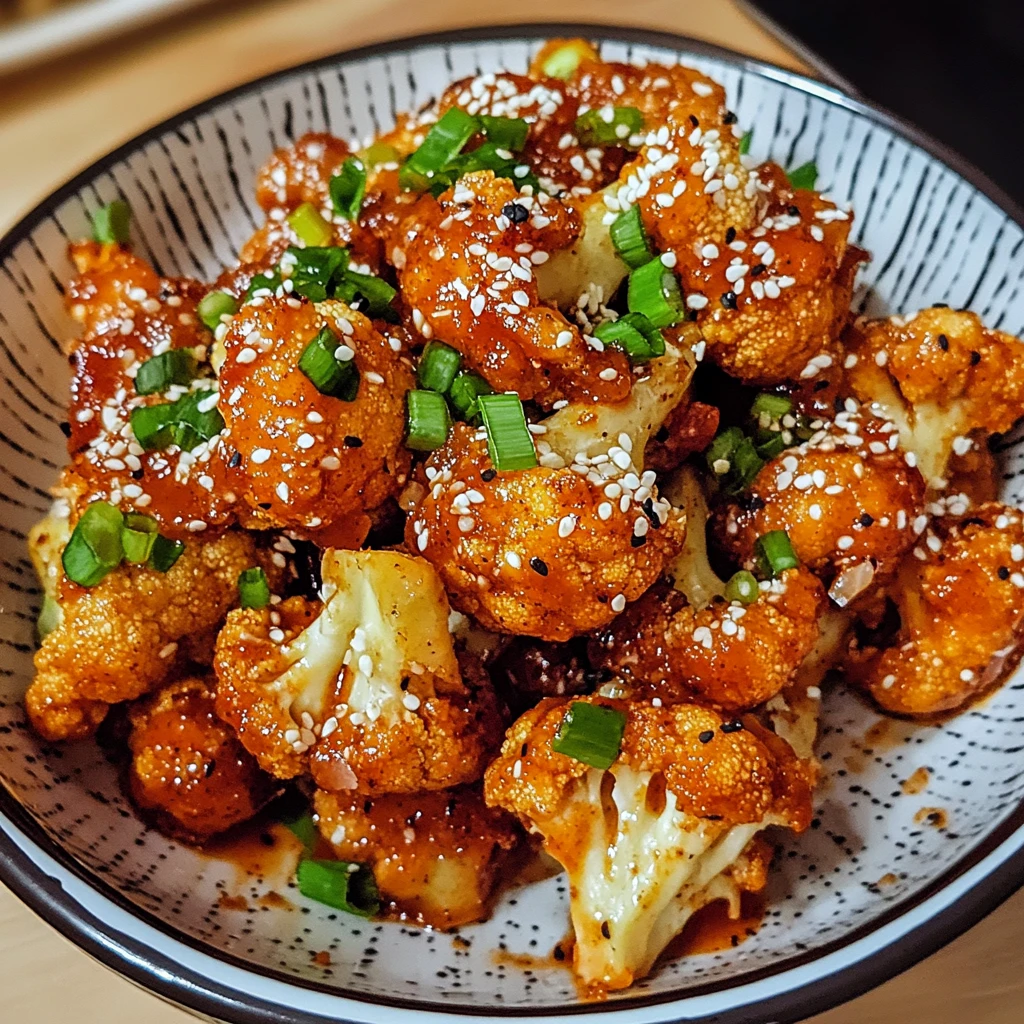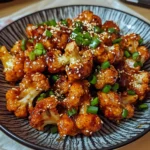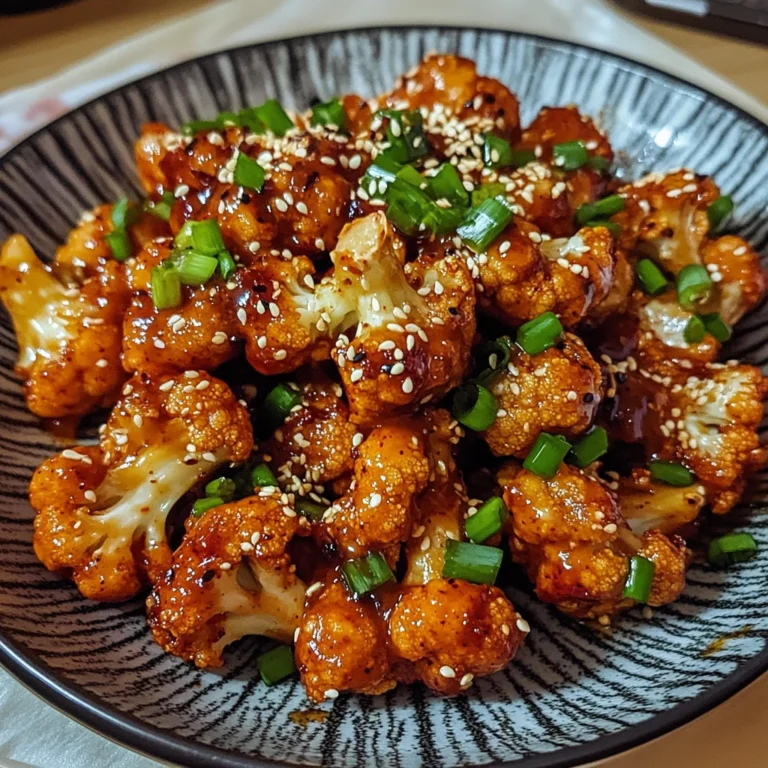Prepare to embark on a culinary adventure with Korean Baked Cauliflower, a delightful dish that combines the bold flavors of Korean cuisine with the versatility of everyone’s favorite cruciferous vegetable. This recipe is a game-changer, transforming humble cauliflower into a showstopping side or main course that’s sure to delight your taste buds. Get ready to experience the perfect balance of spicy, sweet, and savory in every bite.
Table of Contents
Exploring the Flavors of Korean Cuisine
Korean cuisine is renowned for its complex and captivating flavors, which seamlessly blend together in this Korean Baked Cauliflower recipe. The star ingredient, gochujang (Korean red chili paste), lends a unique spicy-sweet punch that is further enhanced by soy sauce, sesame oil, and honey. These ingredients come together to create a sauce that coats the roasted cauliflower florets, resulting in a dish that is both visually stunning and bursting with flavor.
Beyond the vibrant sauce, the nutritional benefits of cauliflower make this dish a wholesome and satisfying choice. As a member of the cruciferous vegetable family, cauliflower is packed with essential vitamins, minerals, and antioxidants that can support overall health and well-being. By incorporating Korean Baked Cauliflower into your diet, you’ll be treating your body to a delicious and nourishing meal.
Ingredients for Korean Baked Cauliflower
To create this flavorful Korean Baked Cauliflower, you’ll need the following ingredients:
- 1 large head of cauliflower, cut into florets
- 2 tablespoons olive oil
- 1/2 teaspoon salt
- 1/2 teaspoon black pepper
- For the Sauce:
- 2 tablespoons gochujang (Korean red chili paste)
- 2 tablespoons soy sauce (or tamari for gluten-free)
- 1 tablespoon sesame oil
- 1 tablespoon honey or maple syrup
- 1 teaspoon rice vinegar
- 2 garlic cloves, minced
- 1 teaspoon grated fresh ginger
- 1 teaspoon toasted sesame seeds (for garnish)
- 2 green onions, sliced (for garnish)
Step-by-Step Instructions for Korean Baked Cauliflower
Now, let’s dive into the simple steps to create this mouthwatering Korean Baked Cauliflower:
- Preheat the Oven: Preheat your oven to 400°F (200°C).
- Season the Cauliflower: In a large mixing bowl, toss the cauliflower florets with olive oil, salt, and pepper until they are evenly coated.
- Roast the Cauliflower: Arrange the seasoned cauliflower florets in a single layer on a baking sheet. Roast for 25-30 minutes, flipping halfway through, until the cauliflower is golden brown and crispy on the edges.
- Make the Sauce: While the cauliflower is roasting, whisk together the gochujang, soy sauce, sesame oil, honey, rice vinegar, garlic, and ginger in a small bowl until the mixture is smooth and well combined.
- Simmer the Sauce: In a small saucepan, cook the sauce over medium heat for 3-5 minutes, stirring occasionally, until it thickens slightly.
- Coat the Cauliflower: Once the cauliflower is roasted, remove it from the oven. Drizzle the sauce over the cauliflower and toss gently to coat. You can return the cauliflower to the oven for an additional 5 minutes if you prefer a more caramelized coating.
- Garnish and Serve: Sprinkle the Korean Baked Cauliflower with toasted sesame seeds and sliced green onions for added flavor and texture. Serve the dish hot as an appetizer, side dish, or main course, accompanied by steamed rice or noodles.

Flavors and Health Benefits of Korean Baked Cauliflower
The combination of flavors in Korean Baked Cauliflower is a true delight for the senses. The spicy-sweet gochujang sauce, infused with umami-rich soy sauce and fragrant sesame oil, creates a delectable balance that coats the crispy roasted cauliflower. The addition of honey or maple syrup lends a subtle sweetness, while the rice vinegar provides a tangy note to cut through the richness.
Beyond the exceptional taste, Korean Baked Cauliflower is also a nutritious choice. Cauliflower is a nutrient-dense vegetable, rich in fiber, vitamins, and antioxidants. It’s an excellent source of vitamin C, vitamin K, and folate, and it also contains compounds like glucosinolates that may have anti-inflammatory and cancer-fighting properties. By incorporating this dish into your diet, you’re not only enjoying a delicious meal but also nourishing your body with essential nutrients.
Serving Suggestions for Korean Baked Cauliflower
Korean Baked Cauliflower is a versatile dish that can be enjoyed in a variety of ways. Serve it as a side dish alongside steamed rice or noodles for a complete and satisfying meal. The bold flavors of the cauliflower also pair beautifully with grilled or roasted meats, making it an excellent accompaniment to your favorite protein dishes.
For a more substantial meal, consider serving the Korean Baked Cauliflower as a main course, perhaps with a side of sautéed greens or a fresh salad. The combination of the flavorful cauliflower and nutrient-rich accompaniments creates a well-balanced and nourishing plate.
To complement the Korean-inspired flavors, consider serving the dish with a refreshing beverage, such as a crisp white wine, a fruity soju cocktail, or a refreshing iced tea. The contrast of the bold, spicy-sweet cauliflower and a cool, refreshing drink can elevate the overall dining experience.
More Related Recipes You Might Enjoy
Frequently Asked Questions (FAQ)
Can I use frozen cauliflower instead of fresh for this recipe?
Yes, you can use frozen cauliflower for Korean Baked Cauliflower; however, there are a few adjustments to consider. First, it’s essential to thaw the frozen cauliflower and drain any excess moisture to avoid a soggy texture. You may need to roast it a bit longer than fresh cauliflower to achieve the desired crispiness. Additionally, keep an eye on the cooking time, as frozen florets may cook faster or slower depending on their size. Finally, be sure to add the sauce after roasting to maintain its flavor and consistency.
How can I make Korean Baked Cauliflower spicier?
If you want to increase the heat level of your Korean Baked Cauliflower, you can adjust the amount of gochujang in the sauce. Start by adding an extra teaspoon for a noticeable kick. You can also incorporate other spicy ingredients, such as red pepper flakes or sliced fresh chili peppers, into the sauce or sprinkle them on top before serving. Additionally, consider serving the dish with a spicy dipping sauce on the side for those who enjoy an extra layer of heat.
What are some good side dishes to serve with Korean Baked Cauliflower?
Korean Baked Cauliflower pairs well with a variety of side dishes. Some excellent options include steamed rice or quinoa to balance the flavors, traditional Korean side dishes like kimchi for a fermented tang, or a simple cucumber salad for a refreshing crunch. You can also serve it alongside other vegetable stir-fries or grilled meats for a complete meal. For a more substantial meal, consider adding a protein like tofu or tempeh, which can be marinated in a similar gochujang-based sauce.
Can I prepare the sauce in advance, and how should I store it?
Yes, you can prepare the sauce for Korean Baked Cauliflower in advance. Simply mix all the sauce ingredients as described in the recipe and store it in an airtight container in the refrigerator for up to one week. When you’re ready to use it, you may need to give it a good stir or warm it slightly to reach the desired consistency, as it may thicken when stored. This makes meal prep more convenient and allows the flavors to meld together, enhancing the overall taste of your dish.
Conclusion
Korean Baked Cauliflower is a true culinary delight that showcases the incredible flavors of Korean cuisine. By roasting cauliflower and coating it in a delectable gochujang-based sauce, you’ll create a dish that is not only visually stunning but also bursting with complex and satisfying flavors. Whether you serve it as a side, a main course, or an appetizer, this recipe is sure to impress and delight your taste buds. So, gather your ingredients, preheat your oven, and get ready to embark on a flavorful journey with Korean Baked Cauliflower!
Looking for more visual inspiration? Follow me on Pinterest, where I share new recipes, dinner tips, and behind-the-scenes kitchen moments every week. Buon appetito!
Print
Discover the Amazing Korean Baked Cauliflower Recipe Today!
- Total Time: 45 minutes
- Yield: 4 servings 1x
- Diet: Vegan
Description
Korean Baked Cauliflower is a delightful dish that combines the bold flavors of Korean cuisine with the versatility of cauliflower, creating a perfect balance of spicy, sweet, and savory.
Ingredients
- 1 large head cauliflower
- 2 tablespoon olive oil
- 1/2 teaspoon salt
- 1/2 teaspoon black pepper
- 2 tablespoon gochujang (Korean red chili paste)
- 2 tablespoon soy sauce
- 1 tablespoon sesame oil
- 1 tablespoon honey or maple syrup
- 1 teaspoon rice vinegar
- 2 garlic cloves, minced
- 1 teaspoon grated fresh ginger
- 1 teaspoon toasted sesame seeds (for garnish)
- 2 green onions, sliced (for garnish)
Instructions
1. Preheat your oven to 400°F.
2. Season the cauliflower: In a large mixing bowl, toss the cauliflower florets with olive oil, salt, and pepper until they are evenly coated.
3. Roast the cauliflower: Arrange the seasoned cauliflower florets in a single layer on a baking sheet. Roast for 25-30 minutes, flipping halfway through, until golden brown and crispy on the edges.
4. Make the sauce: While the cauliflower is roasting, whisk together the gochujang, soy sauce, sesame oil, honey, rice vinegar, garlic, and ginger in a small bowl until smooth.
5. Simmer the sauce: In a small saucepan, cook the sauce over medium heat for 3-5 minutes, stirring occasionally, until it thickens slightly.
6. Coat the cauliflower: Once roasted, remove from the oven. Drizzle the sauce over the cauliflower and toss gently to coat. Return to the oven for an additional 5 minutes if desired.
7. Garnish and serve: Sprinkle with toasted sesame seeds and sliced green onions. Serve hot as an appetizer, side dish, or main course.
Notes
For a spicier dish, increase the amount of gochujang or add red pepper flakes.
You can prepare the sauce in advance and store it in an airtight container in the refrigerator for up to one week.
- Prep Time: 15 minutes
- Cook Time: 30 minutes
- Category: Vegetable Dish
- Method: Baking
- Cuisine: Korean
Nutrition
- Serving Size: 1 cup
- Calories: 150
- Sugar: 5g
- Sodium: 400mg
- Fat: 7g
- Saturated Fat: 1g
- Unsaturated Fat: 6g
- Trans Fat: 0g
- Carbohydrates: 20g
- Fiber: 5g
- Protein: 5g
- Cholesterol: 0mg

